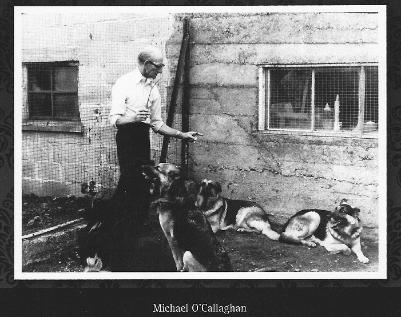The Kerry.S.P.C.A. was established in 1960,starting small with a handful of animal lovers;
Leslie Terkintine, Barrow,Pat Smith, The Nurseries ,Ballyard, Mrs. Mc Cann, The McCann’s Stores, Ash Street/Castle Street Corner,Frank King, Blennerville and Michael Callahan Kevin Barry Villas to name but a few. A number of these people, headed by Mrs McCann, went from door to door collecting donations for the purchase of the premises in Tralee town. When enough funding was collected a property was sought and bought for a princely sum of 550 punts ,with the address of Racket Lane. The kennel area was added a short time later, acquired from the town council for a fee of 5 punts. Now, at the beginning of 2013 we are hoping that this will be the year that we can finally move to a larger premises, which is badly needed to help the number of animals that need our care.
Michael O'Callaghan originally came from the Abbey area of Tralee whilst his wife, Johanna (or Hannie as she was better known) came from Giles Lane in Ballymullin. They spent most of their married life and raised 10 children in Kevin Barry's Villas in Boherbee.
Michael worked in many different jobs including forestry but is perhaps best remembered for his life long dedication to animals and the Kerry SPCA. There was no weather too inclement if an animal was in distress, be it a dog lost in a cave in Limerick or a sheep stuck on a cliff in West Kerry.

Richard "Humanity Dick" Martin

The period surrounding the turn of the 18th century into the 19th saw some of the most tumultuous changes in the history of this country. Britain had lost her American colonies and brought Ireland into a United Kingdom. Slavery was still legal. The French Revolution had taken place and there was serious concern that similar change was about to occur in Britain too. Voting was confined to the landed gentry, though the Great Reform Act was to change that situation. The Industrial Revolution was underway and a war was being fought with France. At such a time, one would have thought that animal welfare would be fairly low down on the list of priorities for politicians. In the case of Colonel Richard Martin, estate owner, lawyer and politician, this was certainly not so.
Colonel Richard Martin MP
Born in 1754 in the West of Ireland to a wealthy estate-owning family, Martin had a deep concern for animals, as did the family and especially his mother, Bridget. Wherever she went she was always accompanied by her dogs. However, as a countryman, Martin was an avid horse rider, a fox hunter, shooter and fisherman and saw no contradiction in these activities and his love of animals. So strong were his feelings that when he inherited the family estate he would punish any of his workers found being cruel to an animal by imprisoning them in a small building on Ballynahinch Lake.
Richard Martin entered the Irish parliament in 1776, not to be confused with the Irish government, which was appointed by the Westminster parliament. After union with Great Britain, Irish MPs were obliged to sit at Westminster, where Martin represented Galway. Here, he was able to pursue causes close to his heart - Catholic emancipation (even though he had received a Protestant education), abolition of the death penalty for forgery and, of course, the protection animals.
Martin was consumed by his passion to prevent cruelty and throughout his time at Westminster he would wander the streets of London seeking out animal abuses, even to the point of physically intervening and putting himself at risk. His work did not go unnoticed in the press and it was his friend the Prince Regent, also sympathetic to Martin’s campaign, who subsequently gave him the nickname “Humanity Dick”.
Though the issue of cruelty to animals in its various forms, usually the beating of horses or the baiting “sports”, had been raised in parliament on a number of occasions, the bills had always failed. Yet slowly the numbers voting were getting tighter, thanks to Martin’s graphic descriptions of abuses and his indefatigable determination to see an end to wanton animal suffering. On 21st July 1822 Martin’s ill Treatment of Horses and Cattle Bill received Royal Assent. It was the first major piece of animal welfare legislation in the world. Known as ‘Martin’s Law’, it paved the way for all other animal welfare legislation.
Throughout the debates that had preceded this momentous event, detractors had made the comparison between baiting and hunting. Martin, a fox hunter himself, relied on other hunters in the House to secure his bill and made the clear distinction between the two activities. There was a world of difference, he argued, between hunting to kill and baiting to torture.
Martin continued to champion the animal welfare cause and in a case of cruelty to a donkey, he himself fought the legal battle, partly due to the lack of seriousness some magistrates regarded the new law. Martin brought the unfortunate beast into the courtroom as evidence, much to the amusement of some court correspondents and the header picture above depicts that scene.
Another supporter of animal welfare law, though someone who was securing his place in history for championing another worthy cause, was William Wilberforce and it was a meeting in 1824 attended by both men that saw the creation of the Society for the Prevention of Cruelty to Animals. The charity was later given its Royal title in 1840 by Queen Victoria.
Difficulties occurred over Martin’s subsequent election in 1826 and mounting debts caused him to flee to France, though he remained involved in the SPCA. Richard Martin died in 1834 and the following year his law was extended to cover all domestic animals.
Acknowledgement: Taken from an article by James Barrington